Picture this: You’re about to host a crucial meeting that could make or break your latest project. You’ve got your presentation polished, your talking points memorized, and your team is buzzing with energy. But there’s one tiny detail that could throw a wrench in the works—the conference room itself.
The meeting room—often overlooked and underappreciated—holds more power than you might think. It’s not just about having four walls and a table; it’s about recognizing that the right space can be the secret ingredient to success.
Conference rooms, with their varied layouts and setups, play a crucial role in determining the success of your meetings.
Why Your Meeting Room Matters More Than You Think
Ever wonder why some meetings leave you energized and inspired, while others have you checking the clock every five minutes? The difference often boils down to the space itself. Your choice of meeting room can make or break your collaborative efforts.
It’s not just a room, it’s a collaborative space. Think about it—where do your best ideas come from? Chances are, it’s not when you’re staring at your computer screen for the tenth hour straight. The magic happens when minds meet, ideas collide, and teams come together. A well-chosen meeting room isn’t just a space; it’s a launchpad for innovation.
Productivity boils down to the details. Ever been in a meeting where half the team is squinting at a tiny screen, or someone’s struggling to hear the speaker? The right conference room layout and setup—complete with a thoughtful arrangement and tech setup—can turn those productivity-killing hiccups into smooth sailing. Suddenly, your team isn’t fighting against the room; they’re working with it.
First impressions count (and second, and third…). Whether you’re wooing a potential client or rallying your team for a big project, the environment matters. A well-orchestrated meeting room doesn’t just impress; it sets the tone for success. It tells meeting attendees, “we’re here to collaborate on a productive outcome.”
With these concepts in mind, let’s dive into the nitty-gritty of choosing the perfect meeting room—from layouts that foster creativity and tech that makes life easier, to those little touches that can turn a good meeting into a great one.
Key Factors for Choosing the Perfect Meeting Room
What makes a good meeting room? The answer isn’t as simple as comfy chairs and a killer A/V setup. The perfect meeting room is a confluence of variables that come together in harmony, to create a space that invigorates those using it. Factors to keep top-of-mind include:
Size and Capacity. A well-chosen space should comfortably accommodate your group size while allowing for some flexibility. Rooms that can adapt to different group sizes through modular furniture or adjustable partitions are particularly valuable, as they can set the tone for various meeting types.
Location and Accessibility. The convenience of accessing the space itself plays a big role in how people feel about attending the meeting. Consider ease of access for both team members and visitors, surrounding noise levels, and the presence of natural light. A room’s suitability can vary throughout the day, so it’s wise to consider these factors at different times.
Room Layout and Flexibility. Look for spaces that offer adaptable furniture arrangements, which allow you to configure the room for various purposes, from formal presentations to collaborative brainstorming sessions. This versatility in meeting room setup can maximize the room’s utility across different meeting types—or provide spur-of-the-moment flexibility to accommodate an evolving meeting. Different meeting room setups, such as hollow square or U-shape, can facilitate effective communication and should be considered to enhance the overall meeting experience.
Technology and Equipment. In the age of distributed teams, technology and equipment are critical components in any meeting room. Ensure the space has reliable Wi-Fi, video conferencing capabilities, easy-to-use display systems, and sufficient power outlets. The goal is to have technology that enhances communication without becoming a distraction.
Comfort and Amenities. Consider factors such as ergonomic seating, proper temperature control, adequate lighting, and nearby access to refreshments. While luxury isn’t necessary, basic comfort can help maintain focus and engagement throughout meetings.
Effective Meeting Room Layouts for Different Purposes
The layout of a space plays a big role in fostering the results you want from a meeting—namely, in facilitating productive discussions and collaborations. Different arrangements can serve various purposes, from formal presentations to interactive brainstorming sessions. Let’s explore some popular meeting room layouts and their benefits:
An optimal conference room setup can significantly enhance meeting productivity and communication.
Remember, an effective conference room setup is essential for fostering collaboration and creativity.
The classic boardroom: formal and focused
The boardroom style—characterized by a long table surrounded by chairs—is ideal for formal meetings and important decision-making sessions. This layout creates a sense of equality among participants, since everyone can see and hear each other clearly. It’s particularly effective for client presentations, strategy sessions, and, of course, board meetings. However, in smaller rooms, this setup might feel cramped, so consider the space available when opting for this layout.
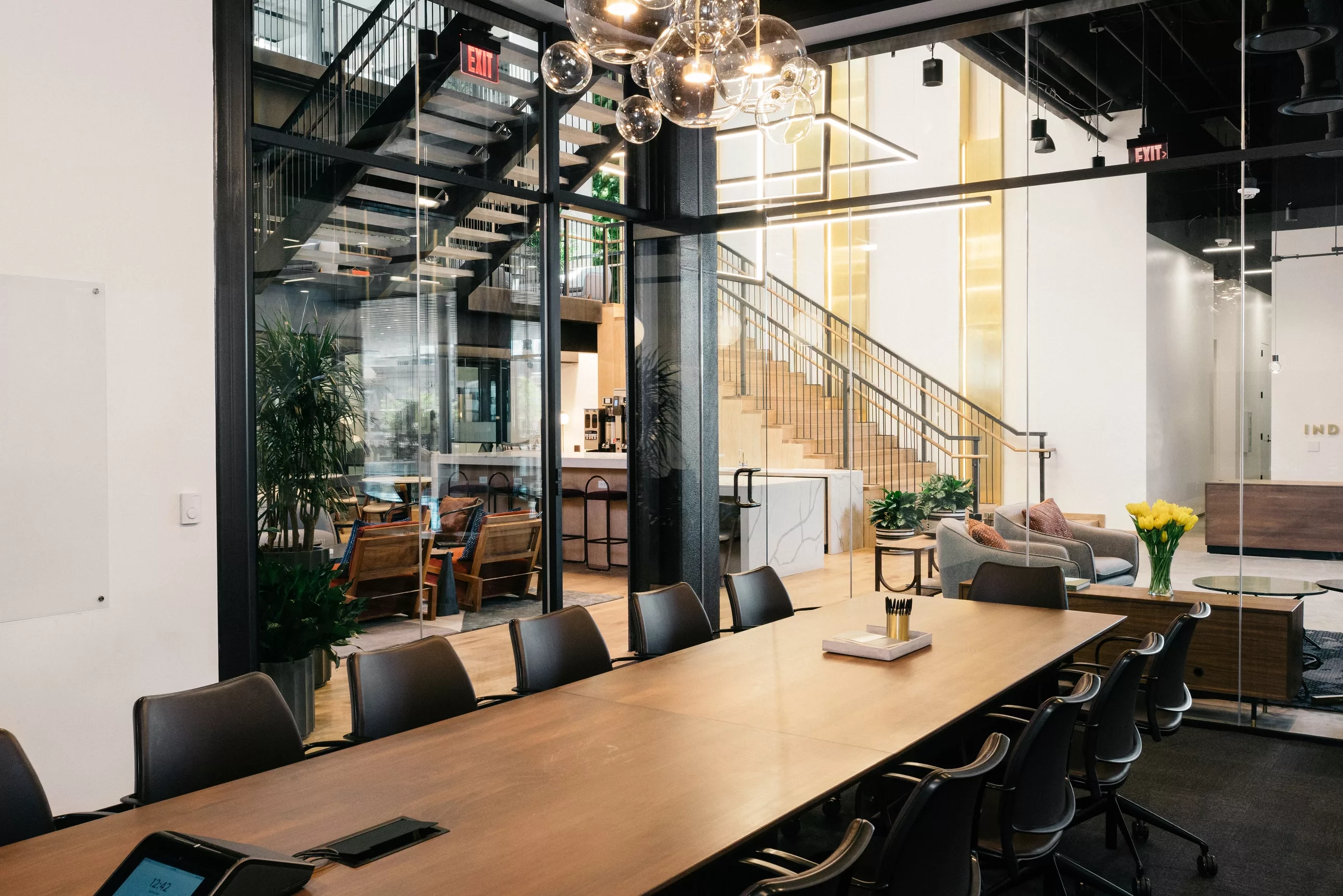
The U-shape: presenter-focused collaboration
The U-shape layout, with tables arranged in a ‘U’ formation, offers a balance between presentation and collaboration. This setup provides a clear focal point for presenters while maintaining a sense of inclusion among participants. It’s particularly effective for training sessions, workshops, or meetings that involve both presentation and group discussion.
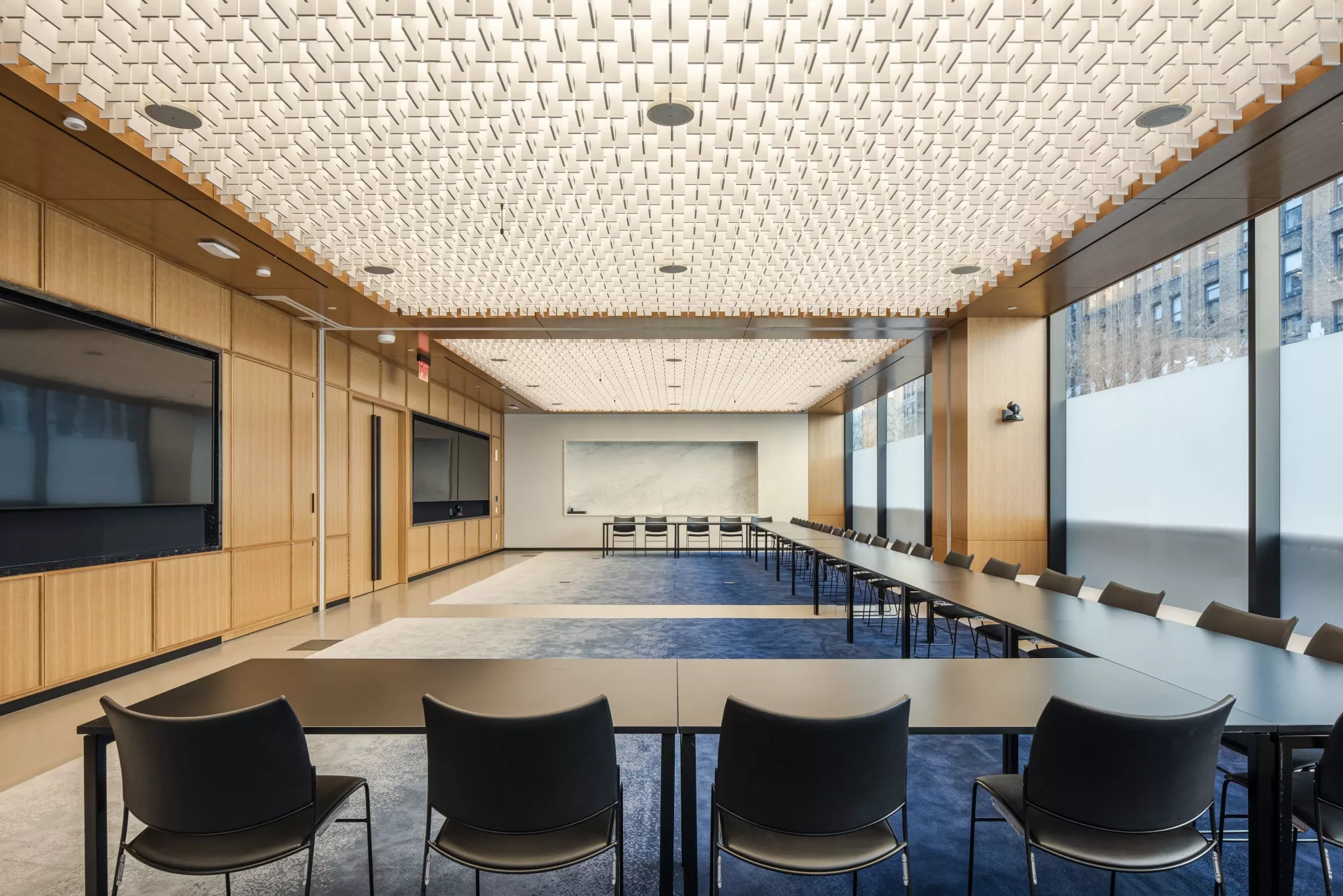
Classroom style: efficient information sharing
Reminiscent of traditional academic settings, the classroom style layout consists of rows of tables facing a presenter area. This arrangement is great for large groups and situations where information primarily flows in one direction. It’s particularly useful for training sessions, conferences, or company-wide announcements. However, it’s worth noting that this layout can feel formal and doesn’t naturally encourage peer-to-peer interaction.
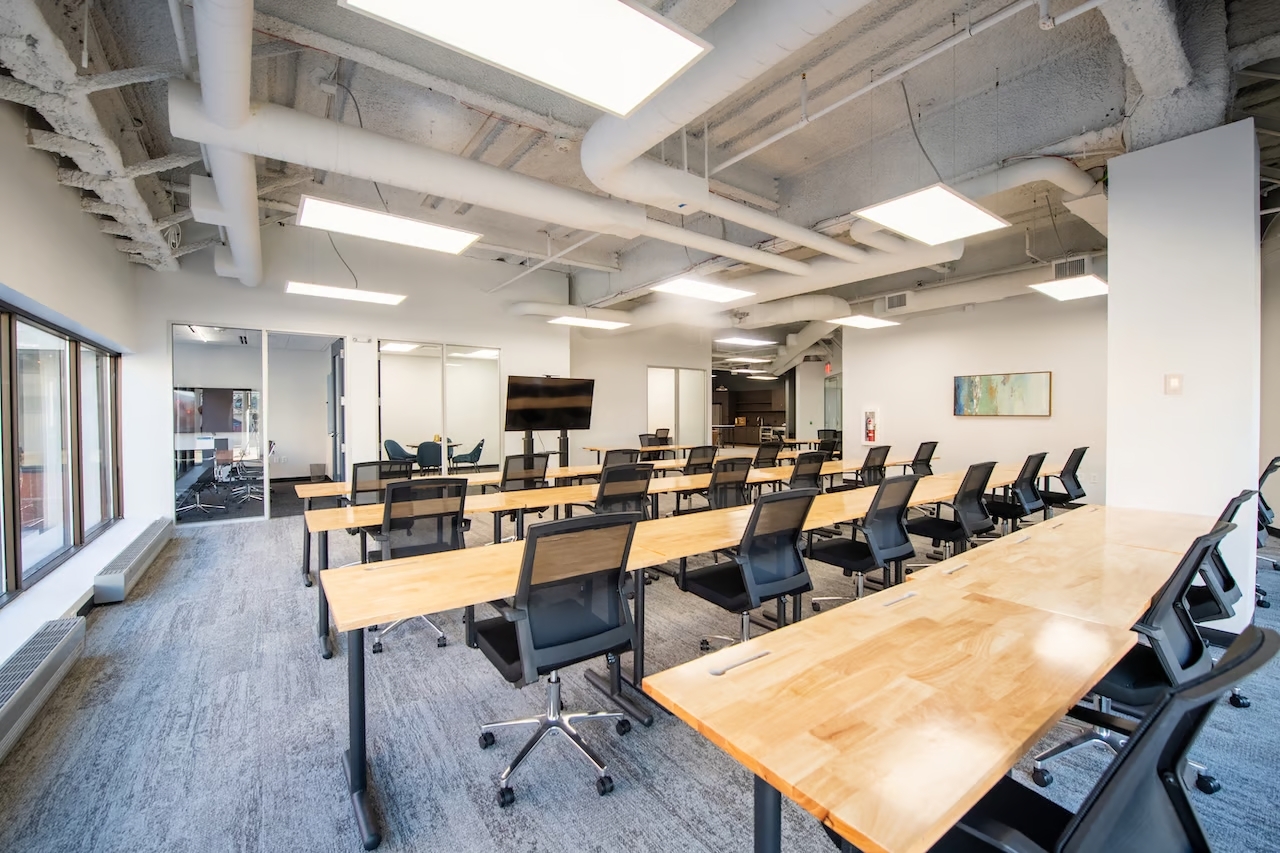
Collaborative clusters: fostering teamwork and creativity
Collaborative clusters involve arranging small groups of tables throughout the room, creating distinct areas for team interactions. This layout is effective for brainstorming sessions, group projects, or when tackling complex problems that benefit from diverse perspectives. It’s an excellent choice when you need to divide a large task among smaller teams or when you want to encourage a variety of ideas to emerge simultaneously.
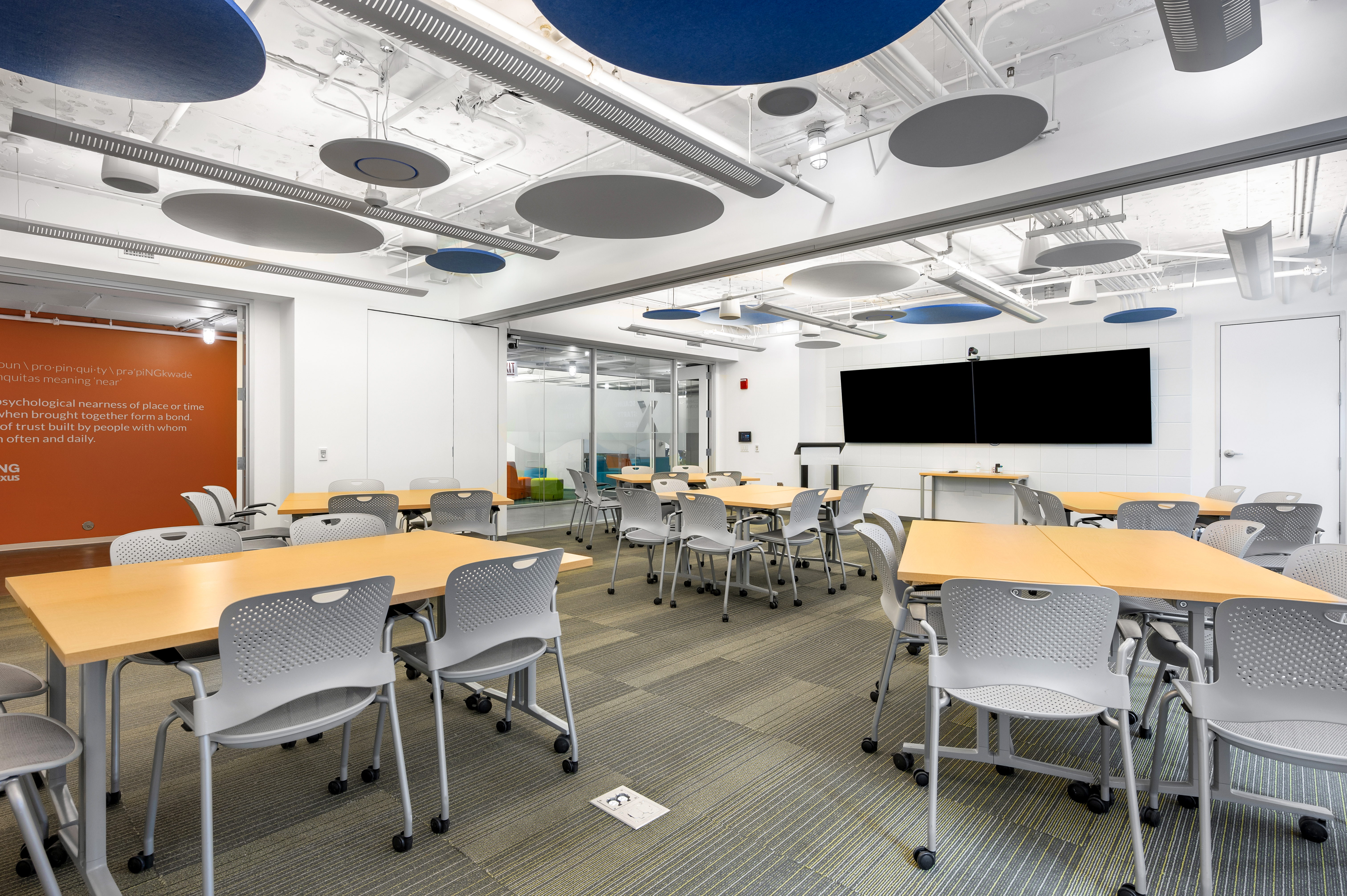
The hollow square: versatile and inclusive
The hollow square layout features a large, rectangular arrangement of tables with an open center. This layout works well for town hall-style meetings, interactive workshops, or sessions that alternate between presentation and discussion modes. The open center allows for easy movement and can be used for demonstrations. That said, ensure that the room is large enough to accommodate this layout comfortably, as it requires more space than some other arrangements.
Remember, the most effective meeting rooms are those that can adapt. Don’t hesitate to experiment with different layouts to find what works best for your team and the goals of each meeting. Sometimes, a simple rearrangement of furniture can significantly uplift the productivity and engagement of a meeting!
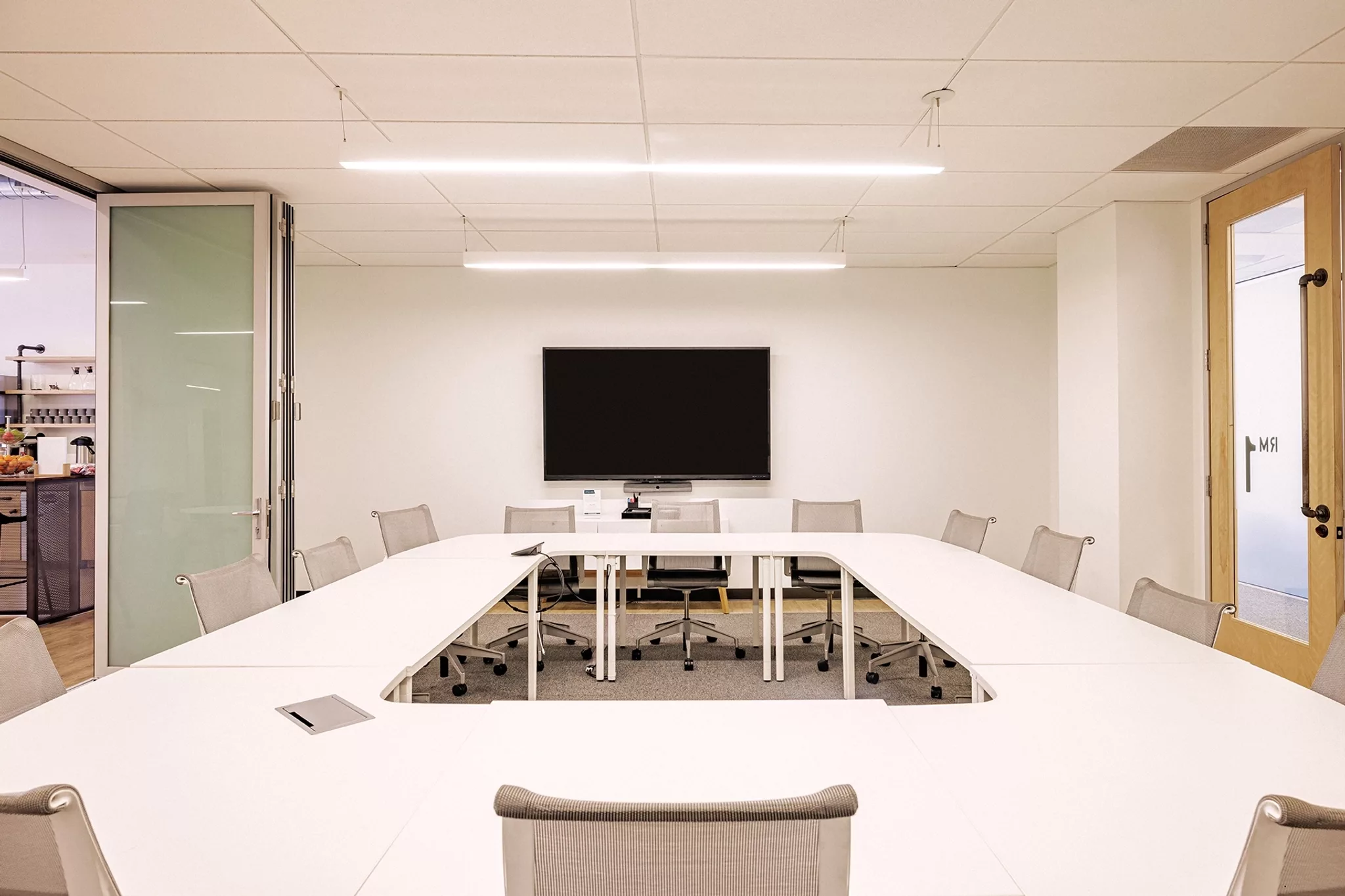
Choosing the Right Meeting Space for Your Business
A good meeting space with an ideal conference room setup is where ideas collide, deals are struck, and your company culture comes to life. Choosing the right space is like selecting the perfect stage. Get it right, and you’ve set the scene for innovation and growth. Get it wrong, and you might find your team’s productivity and morale taking an unexpected intermission.
Here are some factors to keep in mind when picking a space that turns your business meetings from mundane to magnificent:
Assess Your Meeting Needs. Start by evaluating the type of meeting you need to conduct. Understanding your meeting will help you prioritize features in your ideal space. For instance, a creative agency might want a flexible, informal space for a client to consult, while a law firm might need a more formal, private room for the same purpose.
Consider Your Company Culture. Your meeting space should reflect and support your company culture. A startup with a casual atmosphere might benefit from open, adaptable spaces that encourage spontaneous collaboration. In contrast, a more traditional corporate environment might require formal boardrooms for structured meetings.
Evaluate Space Utilization. Look at how often and for how long your team typically uses meeting spaces. If you frequently have short, impromptu meetings, consider multiple small huddle rooms. For businesses that hold longer, less frequent meetings, fewer but larger rooms might be more appropriate.
Plan for Growth. Will the space accommodate your team as it expands? Look for scalable solutions that can adapt to your changing needs. This might involve selecting spaces with movable partitions or opting for a flexible office space provider that lets you easily adjust your meeting room allocation as your business grows.
Balance Privacy and Openness. Strike a balance between privacy and openness in your meeting spaces. While open areas can foster collaboration and creativity, private rooms are important for confidential discussions and focused work. Consider incorporating a mix of both open collaborative areas and enclosed meeting rooms to cater to different meeting needs and preferences.
Integrate Technology Seamlessly. Make sure your chosen meeting space can easily integrate the technology your team relies on. This might include high-quality video conferencing systems, interactive displays, or other software. The technology should enhance (not hinder) your team’s ability to communicate and collaborate effectively.
Location and Accessibility. If you frequently host visitors, consider the location of your meeting spaces. Rooms near the office entrance might be more suitable for client meetings, while internal team meeting spaces can be located deeper within the office. Also, make sure your meeting spaces are accessible to all people, including those with mobility challenges.
The right meeting space doesn’t just meet your needs; it propels your organization forward, turning every gathering into an opportunity for breakthrough. Don’t just look for a space—set the stage for a meeting that accomplishes something great!
Transforming Meetings Through Thoughtful Space Selection
There’s no one-size-fits-all solution when it comes to meeting spaces. In today's digital age, virtual meetings are becoming increasingly important, requiring specific room layouts to enhance engagement and communication. The key is to understand your team’s needs, remain flexible, and be willing to adapt as those needs evolve. By investing time and thought into selecting and optimizing your meeting spaces, you’re not just improving the quality of your meetings—you’re investing in the future of your business. Keep this guide in mind when the time comes to bring the team together.
Get a complimentary $250 Deskpass credit when you sign up for a Teams account today.